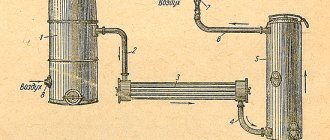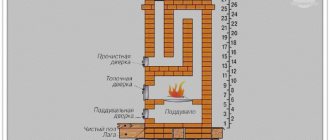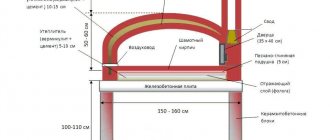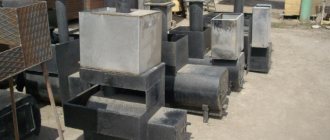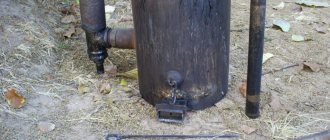What are the benefits of autonomous long-burning heat generators?
Why are autonomous stoves more profitable than centralized heating? The fact is that powerful industrial heating boilers with 100% efficiency lose up to 30% of heat when passing through main and distribution pipelines. Autonomous heating operates without heat loss, and its performance is determined by the efficiency of the boiler used for heating. Homemade stoves may be unsightly in appearance, but have an efficiency of more than 90%. They can be heated with wood, coal and waste.
An efficient and economical wood-burning pyrolysis boiler retains heat for a long time
How does pyrolysis proceed?
The pyrolysis process goes through four stages:
- Drying – excess moisture is removed from the firewood. It is performed during the preparation process or in the firebox due to its heat.
- Pyrolysis is the sublimation of volatile components, the decomposition of heavy components - resins and bitumen to volatiles. The fuel mass begins to carbonize, that is, char.
- Combustion of pyrolysis gases upon reaching the flash point under the influence of high temperature and free oxygen. Carbon combustion begins when the temperature rises above 600 degrees.
- After the combustion of volatile components and the bulk of carbon, reduction reactions begin - the release of carbon monoxide, free hydrogen and oxygen.
In order for the efficiency to be high, when designing the equipment, it is necessary to ensure that the reducing gases are retained in the hot zone and access of heated fresh air is ensured there. With rapid cooling, the energy spent on recovery will fly out into the chimney. Don't forget that carbon monoxide is poisonous.
Note: One of the main advantages of a slow burning stove is its ease of operation. Firewood is loaded into it once or twice a day, and ash is raked out once or twice a week.
What is mining
Waste oil is technical oil that is used inside automobile engines and is drained from them after the end of its service life. That is, it is a 100% petroleum product to which various additives are added to increase the service life of car engine parts that rub together.
Under the influence of high temperatures and air, technical oil loses its technical properties. Therefore, it is replaced with a new one at certain intervals. It is the drained oil that is called used or waste oil. All oils used in car engines of any brand are flammable. That is why they are often used as fuel.
But when burned in a flame, the waste leaves behind a fairly large amount of waste, some of which is toxic. To reduce the concentration of such substances, craftsmen came up with waste oil stoves, which operate on the principle of heating waste oil. It is during the process of heating to high temperatures that the oil begins to break down into components, some of which are flammable mixtures. They burn in fire, releasing enormous thermal energy. Of course, the presence of oxygen in this process is mandatory.
Solid fuel stove potbelly stove
Outside cities, firewood is the most affordable, so the most popular long-burning stove is a wood-burning stove. They heat it not only with firewood from the ridge, but also with waste wood - shavings, sawdust, waste fiberboard and chipboard, small brushwood, straw, etc. There are many heating systems using wood and wood waste. Let's consider the most efficient ones, the efficiency of which is more than 70%.
You can make the simplest potbelly stove with your own hands
A potbelly stove is an economical stove that appeared in Russia after the revolution, during the times of military communism, when many had to endure hardships. The genius of the potbelly stove is that it warms up instantly, as well as the simplicity of its design, the prototype of which was the Russian stove. The upper door is for storing firewood, the lower one is for regulating combustion by supplying air through the slightly open door.
The purpose of a potbelly stove: to keep at least one room warm at minimal cost. When using coal, the grate is removed, and air from the ash pit is directed into the firebox. It is important not to overcrowd it - the volume of the bookmark should be no more than a quarter of its volume. The afterburning chamber is a long horizontal or slightly inclined part of the chimney. Made of metal, it retains heat in the room.
Important! The potbelly stove can operate on all types of solid fuel, except sawdust. It is made in the form of a box made of sheet steel or a round one made of a barrel. Chimney diameter – 85 – 150 mm.
Such a potbelly stove will not only warm you up, but also decorate your interior.
When fired, any potbelly stove becomes red-hot, so its upper surface can be used as a cooking surface. A screen should be installed on the sides at a distance of 40-60 mm from the stove. It protects the room from IR rays and maintains the temperature at an optimal level.
Using a potbelly stove, you can make a homemade long-burning wood-burning boiler. To do this, instead of a screen, a U-shaped metal water heater is installed. The distance between the furnace body and the boiler should be the same as the screen indentation.
DIY assembly
Miracle stoves have gained popularity among many consumers. Sometimes there is a need to be able to quickly and efficiently heat a small room without significant material and time costs. In this case, knowledge about making wood-burning heating devices with your own hands will come in handy. To do this, you only need available materials, tools, desire and ingenuity.
A simple unit from a can
The simplest design is the potbelly stove. To heat a small workshop or garage, you can build a device from an old can. Of course, such a device cannot boast of durability or strength, but it is quickly assembled and easy to install. All the work consists only of arranging the pipe, connecting the parts and building a brick stand or legs. To do this you need to prepare:
- iron can;
- chimney;
- wire;
- some tools;
- welding machine.
Work begins with the horizontal placement of the can and markings. First of all, they designate the place where the vent will be. Usually it is placed under a lid and given the shape of a sickle or rectangle. After this, they begin to create the stove according to the following algorithm:
- A hole is made in the bottom or wall of the container for a pipe, which will act as a chimney outlet.
- A grate is made from steel wire. To do this, bend it, pull it through the lid into the can and carefully unbend it there. At the same time, there should be room in the future stove for fuel (firewood, wood chips, etc.).
- Legs are cut out of the tubes, using a welding machine, they and the smoke outlet are welded to the container.
You can easily make a simple version of a potbelly stove with your own hands from scrap materials.
A simple potbelly stove is ready. The design can be modified by attaching a reflector to the outer wall of the housing, which will prevent heat from evaporating. If you attach handles to the device, it becomes portable. The advantages of homemade stoves of this type include:
- Complete energy independence.
- Solid fuel allows you to save money.
- Versatility - the device can be transported with you and installed in almost any room. It can also be adapted for cooking.
- Easy to assemble: you can use unnecessary iron containers.
- There is no need to install a chimney or build a foundation for the stove.
It is advisable to use a potbelly stove in office premises, garages, sheds
But along with the advantages, potbelly stoves also have a number of disadvantages. So, if the case has thin walls, then over time they will become leaky and the device will fail. In addition, damp and tarry firewood can fill the smoke exit pipe with a thick layer of soot.
A homemade potbelly stove is an effective heater for work spaces and garages. Its assembly will not cause any trouble even for novice craftsmen, and also does not require material investments.
The first method or boiler No. 1
The natural vortex is replaced by forced pressurization, and pyrolysis is divided into two stages in space: a pyrolysis chamber, a nozzle (nozzle) that forms a flow of pyrolysis gases, and a combustion chamber. The nozzle is made so that there are no parasitic turbulence behind the mass of fuel. To ensure complete control over the process, through blowing is necessary.
Features of direct-flow and heat-storing pyrolysis boilers:
Note: the rate of pyrolysis and the composition of gases is affected by the type of fuel. These factors are taken into account by regulating the back pressure at the outlet by throttling the chimney. Regulators for industrial solid fuel boilers are equipped with marks indicating the recommended type of fuel.
The efficiency of once-through boilers can be above 90%. They require power to operate. When switching off, to further start the system, it is necessary to remove the sintered mass and make a new filling in the firebox.
Steam-assisted solid fuel boilers use different types of fuel
How to make a stove for testing with your own hands: drawings, videos, photos of the process
Heating a garage is not the most important problem. But many car owners who often spend time with their iron friend try to make this pastime comfortable. Therefore, they think about which unit to install so that both heat and operating costs are minimal. One such option is a heating device that runs on waste oil. Fortunately, this type of fuel is one of the cheapest and most accessible. Therefore, in today’s review we will understand what the stove is assembled from during testing with our own hands. Drawings, videos and photos will help you analyze in detail the entire production process.
The second method or boiler No. 2
A pyrolysis boiler with a water heater, which does not require electricity or automation, works on the principle of counteracting the two laws of the square-cube. This refers to the laying of fuel and lining of fireclay bricks. Algorithm for the operation of a brick kiln:
Loading firewood or coal into a boiler with a heat buffer is done gradually. Sharp temperature fluctuations are contraindicated for her. If too sluggish fuel is used, it may stall. If it is too flammable, there is a risk of an emergency. If the first heat is not suppressed, the efficiency will not exceed 76-78%, since instantaneous heat transfer from the lining to the outside is excluded.
English fireplace
There are legends about the attractiveness of fire; its decorative and aesthetic function is of great importance for humans. Can an ordinary person build a long-burning fireplace in his home to enjoy not only the warmth, but also the beauty of fire? The main thing in such devices is not heat transfer and efficiency, but the ability to contemplate the fire during the day.
A fireplace in the English style, made with your own hands, will decorate your interior
There are such designs, and they were invented by the British. A classic English fireplace has a smoke tooth, reminiscent of a threshold in a Russian stove, which forms a circulation of flue gases that does not allow fresh air to rise, directing it into the filling, as happens in a potbelly stove.
Due to the large mouth, the efficiency of the fireplace is small - no more than 50%, even if there are smoke circulations in the chimney. Smoldering and heat generation from evening to morning occurs only when using Cornish coal or similar coking coal. They say that in the old days English lords lit their fireplaces with the rhizomes of pine trees growing on the coastal cliffs.
An example of another “long” fireplace is an ordinary Dutch fireplace. Before kindling, the ash pit is closed, firewood is loaded onto a quarter of the firebox, its door remains wide open. The main part of the heat flies into the pipe, but the decorative effect is ensured.
How to make a stove at work with your own hands
As mentioned above, the main requirement for the device is the connection of parts and pieces by welding. Therefore, owning a welding machine is a paramount necessity. And the better the skills, the more reliable the unit.
Furnace using a gas cylinder: drawings and types of structures
There are quite a large number of designs of gas cylinder stoves that operate on waste oil. Let's look at the most popular models among garage owners.
The simplest option
This option is not only easy to manufacture, because the cylinder is a ready-made container that just needs to be modified, but with high reliability of welded joints. Where to start and what to do - sequence of operations:
- You need to open the valve and drain the remaining gas from the cylinder. It should remain open for several days. It's better to rinse the tank.
- The balloon is cut across half its length using a grinder. You will need the top.
- The valve is knocked off. This can be done with a sledgehammer if it suddenly does not unscrew itself.
- A pancake with a diameter equal to the diameter of the cylinder is cut out of a metal sheet 3-4 mm thick.
- It is welded to the cut edge.
- A piece 60-100 cm long is cut from a pipe with a diameter of 100 mm.
- Several holes with a diameter of 6-8 mm are drilled in it. There should be six holes around the perimeter, 8-10 along them. That is, the number of holes is within 50 pieces.
- The pipe is welded to the former installation site of the valve.
- Now, just on the side of the cylinder lid, another hole with a diameter of 25-30 mm is made, to which a 32 mm pipe, 50 mm long, is welded. A damper is installed on it. It is through this that waste oil will be poured into the furnace and the fuel will be ignited.
Attention! By opening and closing the damper, you can regulate the combustion process inside the fuel tank.
Such a small stove may not be equipped with an afterburning chamber. It is enough to install a good inclined chimney.
Small stove without afterburner
Stove using an inflated gas cylinder
This is a more complex design in design and manufacture, but more effective than the previous one.
| Photo | Description of work |
| Air is pumped out of the propane tank through an open valve. | |
| A hole is cut in the top cover where the valve is installed. This can be done simply by pre-drilling the holes with a drill and drill. A pipe will be welded to the hole. | |
| Markings are made for two openings in the cylinder, one above the other. Rectangular holes are cut along them. The cut pieces will be used as doors. | |
| To do this, regular loops are welded to them and the cylinder. | |
| It should look something like this. | |
| A pancake with a diameter equal to the inner diameter of the cylinder is cut out of a metal sheet. A round hole is made in the middle for a 100 mm pipe. The pancake is inserted between the installed doors, where it is welded. That is, it will act as a partition. | |
| A perforated device is made from a piece of 100 mm pipe. | |
| It is installed in the hole on the pancake so that the holes are inside the lower chamber. |
Then an air duct must be connected to the pipe; this can be the same pipe through which air will be forced into the combustion chamber using a fan. The chimney is connected to the side of the cylinder or next to the air duct. The photo below shows a drawing that shows a schematic diagram of the operation of such a device.
The principle of operation of the stove in pressurized mining
Do-it-yourself drip-type stove
The principle of operation of dropper stoves has already been discussed above. In them, the main structural element is a bowl into which fuel will be supplied in the form of drops. The feed intensity will depend on the diameter of the bowl and the oven temperature setting. There are several types of such units. Some of them are shown in the photo below.
Types of dropper stoves working in mining
Of these, the first two positions are furnaces that operate in standard mode. The last two work with inflation. In this case, fuel can be supplied from the side, as shown in the first three diagrams, or from above through the air supply barrel.
The manufacture of such a unit is carried out in almost the same way as in the previous case. But there are also some differences:
Other types of stoves in development
Of course, a gas cylinder is an ideal option for making potbelly stoves using waste oil. But there are other materials, and not necessarily new ones, from which stoves are assembled. This can be a pipe with a wall thickness of at least 5 mm or sheet iron with a thickness of 4-5 mm. In addition, craftsmen offer various designs that differ from each other in additional useful functions. Let's look at some of them.
Waste oil furnace with water circuit
This is a more complex design, but it has one very big advantage over other models. With its help, you can heat not only the garage space, but also the water tank. You can also use it as a heating boiler to heat large rooms. That is, the stove is connected through a heat exchanger to a water heating system, where piping is done with the installation of radiators.
There are three design modifications:
- The heat exchanger, also known as a coil (in this case), is wound around the stove from the outside. Of the three options, it is easier to implement.
Schematic diagram of a boiler with a water jacket
Open and closed type furnace
What is the difference between the two models. A homemade open-type mining furnace consists of two chambers connected to each other by a perforated pipe. The latter has an open appearance, it is not protected by anything, and air is taken directly through the holes into the afterburner chamber. In this case, the pipe can be round or rectangular.
Stove with afterburner made of profiled pipe
The closed type design is a full-fledged unit, hermetically sealed on all sides. An afterburner made of the same perforated pipe is installed inside it. Only air is supplied into it from above using a fan. Essentially, this is a forced-air oven. True, small devices are not equipped with fans. The natural laws of physics apply in them, when air with a lower temperature flows by gravity into an area where the temperature is much higher.
Closed stove made from a gas cylinder
The simplest DIY stove
Long-burning solid fuel boilers, which were mentioned above, are difficult to make with your own hands according to the scheme. The drawings below will help the DIYer build a simple heating device on his own. Equipment power – 35 kW, efficiency – up to 85%, combustion duration – 12 hours. Coal or fuel pellets are used as fuel. Loading with wood reduces efficiency to 75%, burning duration is reduced to 8-10 hours.
A drawing of the design of the stove will help you make it yourself
Slobozhanka stove review
It is worth noting that the Slobozhanka stove is the subject of a separate article, so this is exactly what we are talking about. This is a long-burning convection oven, which has several models with different parameters and purposes.
Slobozhanka stoves are designed for people with average incomes who need an effective and inexpensive heat source. They work on almost any fuel, but it must be of plant origin. For example, pine needles, cones, straw, sawdust. That is why this type of stove is very popular for those who heat household facilities.
Slobozhanka stove: characteristics
It is worth noting that the Slobozhanka stove has a simple design. Therefore, making it with your own hands will not be difficult for a person who knows how to work with a welding machine. The various models differ from each other only in the air supply system. And this does not depend on the ignition units and their presence, additional loading, the size of the combustion chamber and other elements.
In all models, air is supplied to the very bottom of the firebox, then it rises to the fuel combustion zone. The main difference is only in the channel design of the air distribution unit. With all this, air delivery and the design of the supply unit in the furnace determine the forms of upper combustion of the incoming fuel. The forms are as follows:
1. Slobozhanka stoves have top-side combustion, that is, the fuel burns from the top to the bottom of the firebox, but in the coal from the chimney.
2. Top-center combustion. This means that the fuel burns away from the fuel chamber, from the center to the very bottom.
Based on this, there are three main models of stoves that are used in everyday life:
The first type has a side air supply from the downward side of the firebox. This model has a pipe in the shape of the letter “L”, from where the air is distributed through the channel of the perforated screen into the combustion zone.
The second type has a central lower air supply, which is distributed from bottom to top. The center channel is located in the very center of the combustion chamber.
The third type of model has a lower side feed, which is distributed from the sides and then goes up the channel into the fuel combustion zone.
Typically the combustion process lasts about 8 hours. It is clear that firewood will smolder the longest and release energy. But straw or pine needles can only burn for about six hours. So it’s worth taking these features into account when heating the room.
Slobozhanka stove: application
Since the Slobozhanka model is a solid fuel and conventional stove, it usually burns for a long time and does not require special supervision. Since the appearance of the device does not meet the requirements of designers, this stove is most often used for utility or industrial premises.
It is worth considering that full heating can be in a room or building with a volume of no more than 100 cubic meters. Usually these are greenhouses, workshops, car service booths, workshops or garages. There is no need to clean such a stove often; it does not require special care at all, which often comes in handy.
In cases where uninterrupted operation of the device is necessary, you can add additional fuel and not worry about cleaning the compartment.
Scheme and possibility of design improvement
Slobozhanka is a full-fledged miracle wood-burning oven with a hob. Air is supplied to the smoldering material from the side along a U-shaped path: down the L-shaped air duct and then through the perforated casing. Access is provided to all layers, which promotes more active pyrolysis, so Slobozhanka works well on coal and pellets. This is an economical device with an efficiency of more than 80%.
The power of the equipment can be increased by complicating its design: stretching the internal perforated casing over the entire circumference. To equip the blower with a throttle, a third narrow casing is made to cover the air intakes from the outside.
Vertical Slobozhanka is made on the basis of a barrel
Slobozhanka with a mushroom hat
The traditional Slobozhanka has disadvantages:
- It does not accept fatty and tarry fuels. Household waste, chipboard and fiberboard waste form hard deposits on the edges of the holes in the internal casing and the perforated casing of the air duct.
- Careful refueling of the unsmoldered filling is required, since at least a small smoldering area should remain free near the perforation of the casing. If this is not provided for, after the filling burns out, the stove will cool down.
The design with a central conical perforated air duct with a mushroom cap is the development of one of the Soviet mailboxes. Created on the basis of Slobozhanka. The cone was freely installed in the discharge hatch of the firebox and removed for cleaning.
The edges of the cap threw fuel to the edges, and a smoldering ring was formed under it, necessary for lighting the stove. Additional loading could be made in any quantity and at any time. Due to the edges of the hat, air was directed to the smoldering zone, which ensured the omnivorous design.
The disadvantage of the “slobozhanka with fungus” was that when burning household waste or damp pine it was necessary to check the soot. The cone could have become stuck tightly. In this case it was difficult to remove it without distorting it.

